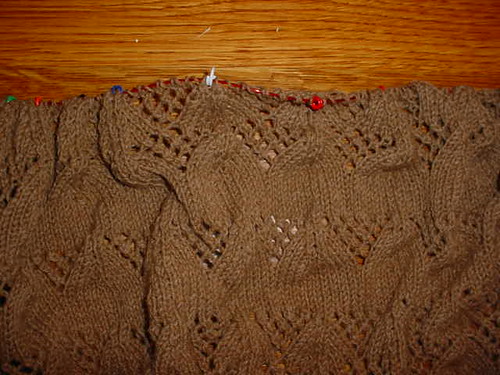I added another half-repeat to the shawl. (The pattern has a very long repeat; 46 rows of something like 340 stitches). The shawl is about half-done now.

As always, lace shawls don't look like much on the needles - it takes getting them finished, and especially blocked, to stretch everything out and make the fabric lie flat.
The pattern is nominally based (I guess) on a Tibetan design; the name ("Bird's nest") comes from the fact that women will roam the fields in the area where cashmere goats live and find tufts of the shed hair (even in things like old birds' nests) and will then spin it up. (The implication being, these are women who could not afford to buy even basic wool yarn in a shop). I've also read of something similar that poor Scotswomen did - roaming the fields looking for tufts of wool that would get caught on bushes and such. (It's kind of heartbreaking to think of how long a person would have to scour the countryside to accumulate enough tufts of wool to spin enough yarn for a sweater, even for a small child.)
The yarn I am using on this is a camel hair yarn - the shawl in the book WAS made using a cashmere, but camel was a lot more affordable (seeing as I neither spin, nor live in an area where I could wander around and pick bits of cashmere from the shrubbery.)
1 comment:
When my family visited England in the 1980's, we stopped our car along the moor and found tons of sheep wool caught in the gorse. The sheep wouldn't pose for pictures (which is what I wanted) and as I didn't knit then, I didn't care about the wool. They were pretty ragged looking sheep so maybe it has to do with the breed's fleece style.
HIstorically, gleaning shows up quite a lot - both crops and fiber.
Post a Comment